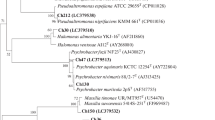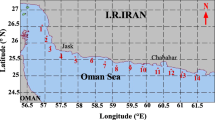Abstract
Bacteria and fungi were recovered from deep-sea sediments of the Middle Pacific, West Pacific, and East Pacific by using different isolation media. More than 150 strains were isolated, 90 of which were selected for initial identification and cytotoxic activity tests. The strains were identified by 16S rRNA gene sequencing and grouped into 19 different genera, including Acinetobacter, Arthrobacter, Bacillus, Burkholderia, Halomonas, Hyphomicrobium, Kocuria, Marinobacter, Microbacterium, Micrococcus, Nocardiopsis, Phialocephala, Planomicrobium, Planococcus, Leifsonia, Pseudoalteromonas, Pseudomonas, Psychrobacter, Shewanella, and Streptomyces. The cytotoxicities of the strains toward the mouse temperature-sensitive p34cdc2 mutant tsFT210, murine lymphoma P388 and human leukemia K562 cell lines were determined preliminarily by the sulforhodamine-B (SRB) or methyl thiazolyl tetrazolium (MTT) bioassay method. The metabolites from three bacteria (Bacillus sp. EP39, Pseudomonas sp. WP133, and Pseudomonas sp. WP168) and one fungus (Phialocephala sp. FL30r) had strong cytotoxic activities (Inhibition rate > 50%). Nine cytotoxic compounds belonging to phenazine, indole, polyether, and ester were isolated from them through bioassay-guided chromatography and identified by spectral methods.



Similar content being viewed by others
References
Ayuso A, Clark D, González I, Salazar O, Anderson A, Genilloud O (2005) A novel actinomycete strain de-replication approach based on the diversity of polyketide synthase and nonribosomal peptide synthetase biosynthetic pathways. Appl Microbiol Biotech 67:795–806
Bowman JP (2001) Methods for psychrophilic bacteria. In: Paul JH (ed) Methods in microbiology. Academic Press, New York, pp 591–614
Bull AT, Ward AC, Goodfellow M (2000) Search and discovery strategies for biotechnology: the paradigm shift. Microbiol Mol Biol Rev 64:573–606
Chen X, Zhang Y, Gao P (2004) Progress in deep-sea microbiology. J Marine Sci 28:61–66
Chen M, Xiao X, Wang P, Zeng X, Wang F (2005) Arthrobacter ardleyensis sp. nov., isolated from antarctic lake sediment and deep-sea sediment. Arch Microbiol 183:301–305
Damare S, Raghukumar C, Raghukumar S (2006) Fungi in deep-sea sediments of the Central Indian Basin. Deep-Sea Res- I 53:14–27
Dang H, Zhu H, Wang J, Li T (2009) Extracellular hydrolytic enzyme screening of culturable heterotrophic bacteria from deep-sea sediments of the Southern Okinawa Trough. World J Microbiol Biotechnol 25(1):71–79
Das S, Lyla PS, Khan SA (2006) Marine microbial diversity and ecology: importance and future perspectives. Curr Sci 90:1325–1335
Faulkner DJ (2002) Marine natural products. J Nat Prod 19:1–48
Gaudette HE, Flight WR, Toner L, Folger DW (1974) An inexpensive titration method for determination of organic carbon in recent sediments. J Sediment Petrol 44:249–253
Gerhard B, Gerhard L, Tobias AMG, Tsuruta H, Jörg M, Katja M, Stefan S, Karsten S, Rüdiger S, Jutta W, Johannes FI, Sanja P, Olexandra B, Müller WEG (2005) The first sorbicillinoid alkaloids, the antileukemic sorbicillactones a and b, from a sponge-derived Penicillium chrysogenum strain. Tetrahedron Lett 61:7252–7265
Gontang EA, Fenical W, Jensen PR (2007) Phylogenetic diversity of Gram-positive bacteria cultured from marine sediments. Appl Environ Microbiol 73:3272–3282
Gorajana A, Venkatesan M, Vinjamuri S, Kurada BV, Peela S, Jangam P, Poluri E, Zeeck A (2007) Resistoflavine, cytotoxic compound from a marine actinomycete, Streptomyces chibaensis aubn1/7. Microbiol Res 162:322–327
Gustafson K, Roman M, Fenical W (1989) The macrolactins, a novel class of antiviral and cytotoxic macrolides from a deep-sea marine bacterium. J Am Chem Soc 111:7519–7524
Jannasch HW, Wirsen CO, Taylor CD (1983) Deep-sea bacteria: isolation in the absence of decompression. Science 216:1315–1317
Jeong SY, Shin HJ, Kim TS, Lee HS, Park S, Kim HM (2006) Streptokordin, a new cytotoxic compound of the methylpyridine class from a marine-derived Streptomyces sp. Kordi-3238. J Antibiot 59:234–240
Jeong SY, Park SY, Kim YH, Kim M, Lee SJ (2008) Cytotoxicity and apoptosis induction of Bacillus vallismortis bit-33 metabolites on colon cancer carcinoma cells. J Appl Microbiol 104:796–807
Kelecom A (1999) Chemistry of marine natural products: yesterday, today, and tomorrow. An Acad Bras Cienc 71:249–263
Kelecom A (2002) Secondary metabolites from marine microorganisms. An Acad Bras Cienc 74:151–170
Kim SJ, Kato C (2010) Sampling, isolation, cultivation, and characterization of piezophilic microbes. In: Timmis KN (ed) Handbook of hydrocarbon and lipid microbiology. Springer-Verlag Press, Berlin Heidelberg, pp 3870–3880
Laursen JB, Nielsen J (2004) Phenazine natural products: biosynthesis, synthetic analogues, and biological activity. Chem Rev 104:1663–1685
Li S, Xiao X, Li J, Luo J, Wang F (2006) Identification of genes regulated by changing salinity in the deep-sea bacterium Shewanella sp. WP3 using RNA arbitrarily primed PCR. Extremophiles 10:97–104
Li D, Wang F, Xiao X, Zeng X, Gu Q, Zhu W (2007a) A new cytotoxic phenazine derivative from a deep sea bacterium Bacillus sp. Arch Pharm Res 30:552–555
Li D, Wang F, Cai S, Zeng X, Xiao X, Gu Q, Zhu W (2007b) Two new bisorbicillinoids isolated from a deep-sea fungus, Phialocephala sp. Fl30r. J Antibiot 60:317–320
Li D, Wang F, Xiao X, Fang Y, Zhu T, Gu Q, Zhu W (2007c) Trisorbicillinone a, a novel sorbicillin trimer, from a deep sea fungus, Phialocephala sp. Fl30r. Tetrahedron Lett 48:5235–5238
Lin J, Yan X, Zheng L, Ma H, Chen H (2005) Cytotoxicity and apoptosis induction of some selected marine bacteria metabolites. J Appl Microbiol 99:1373–1382
Liu R, Zhu T, Li D, Gu J, Xia W, Fang Y, Zhu W, Gu Q (2007) Two indolocarbazole alkaloids with apoptosis activity from a marine-derived actinomycete z (2) 039–2. Arch Pharm Res 30:270–274
Martin GDA, Tan LT, Jensen PR, Dimayuga RE, Fairchild CR, Raventos-Suarez C, Fenical W (2007) Marmycins a and b, cytotoxic pentacyclic c-glycosides from a marine sediment-derived actinomycete related to the genus Streptomyces. J Nat Prod 70:1406–1409
Mosmann T (1983) Rapid colorimetric assay for cellular growth and survival: application to proliferation and cytotoxicity assays. J Immunol Meth 65:55–63
Munson MA, Nedwell DB, Embley TM (1997) Phylogenetic diversity of archaea in sediment samples from a coastal salt marsh. Appl Environ Microblol 63:4729–4733
Raghukumar C, Raghukumar S, Sheelu G, Gupta SM, Nagender Nath B, Rao BR (2004) Buried in time: culturable fungi in a deep-sea sediment core from the Chagos Trench, Indian Ocean. Deep-Sea Res I 51:1759–1768
Skehan P, Storeng R, Scudiero D, Monks A, Mcmahon J, Vistica D, Warren JT, Bokesch H, Kenney S, Boyd MR (1990) New colorimetric cytotoxicity assay for anticancer-drug screening. J Natl Cancer Inst 82:1107–1112
Sogin ML, Morrison HG, Huber JA, Welch DM, Huse SM, Neal PR, Arrieta JM, Herndl GJ (2006) Microbial diversity in the deep sea and the underexplored “Rare biosphere”. Proc Natl Acad Sci U S A 103:12115–12120
Takai K, Horikoshi K (1999) Genetic diversity of archaea in deep-sea hydrothermal vent environments. Genetics 152:1285–1297
Takami H, Kobata K, Nagahama T, Kobayashi H, Inoue A, Horikoshi K (1999) Biodiversity in deep-sea sites located near the south part of Japan. Extremophiles 3:97–102
Trischman JA, Jensen PR, Fenical W (1998) Guaymasol and epiguaymasol: aromatic triols from a deep-sea Bacillus isolate. Nat Prod Res 11:279–284
Vita-Marques AM, Lira SP, Berlinck RGS (2008) A multi-screening approach for marine-derived fungal metabolites and the isolation of cyclodepsipeptides from Beauveria felina. Quím Nova 31:1099–1103
Whittenbury R, Phillips KC, Wilkinson JF (1970) Enrichment, isolation and some properties of methane-utilizing bacteria. J Gen Microbiol 61:205–218
Xiao X, Wang P, Zeng X, Bartlett DH, Wang F (2007) Shewanella psychrophila sp. nov. and Shewanella piezotolerans sp. nov., isolated from west Pacific deep-sea sediment. Int J Syst Evol Microbiol 57:60–65
Xu M, Wang P, Wang F, Xiao X (2004) Microbial diversity in deep-sea sediments collected from different stations of Pacific. Mar Biotechnol 6:S161–S167
Zhang L, An R, Wang J, Sun N, Zhang S, Hu J, Kuai J (2005) Exploring novel bioactive compounds from marine microbes. Curr Opin Microbiol 8:276–281
Zobell CE (1941) Studies on marine bacteria. I. The cultural requirements of heterotrophic aerobes. J Mar Res 4:42–75
Acknowledgments
We are grateful to the crews on HaiYang No.4 and DaYang No.1 for assisting in sample collection. This work was supported by the Chinese Ocean Mineral Resource R & D Association (DYXM-115-02-2-01) and Chinese National High-Tech R&D Program (2007AA091904).
Author information
Authors and Affiliations
Corresponding author
Rights and permissions
About this article
Cite this article
Zeng, X., Xiao, X., Li, D. et al. Isolation, identification and screening of microorganisms for cytotoxic activities from deep sea sediments at different pacific stations. World J Microbiol Biotechnol 26, 2141–2150 (2010). https://doi.org/10.1007/s11274-010-0396-5
Received:
Accepted:
Published:
Issue Date:
DOI: https://doi.org/10.1007/s11274-010-0396-5




